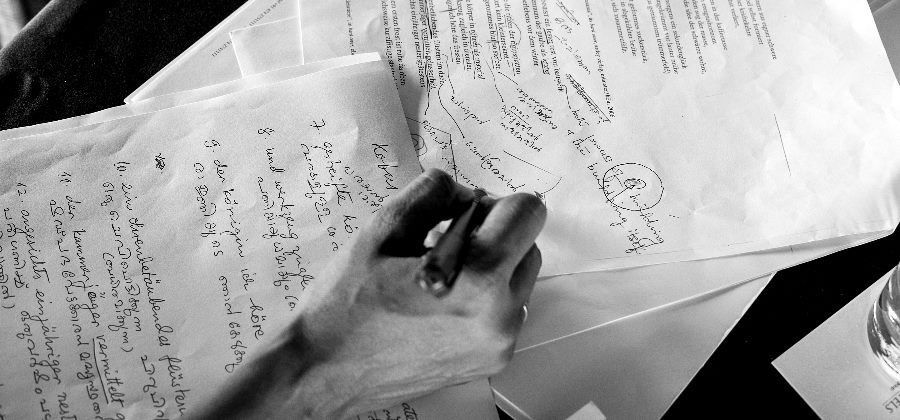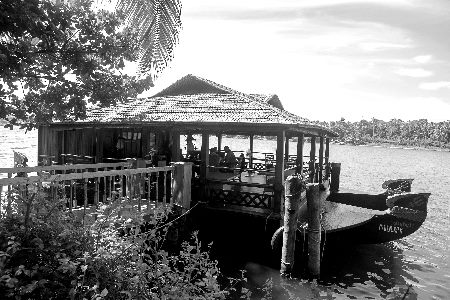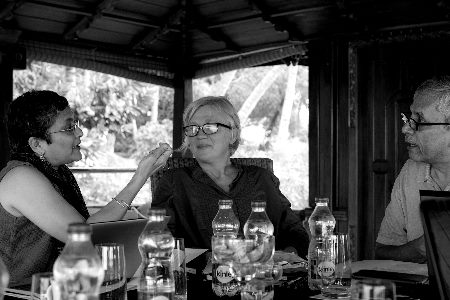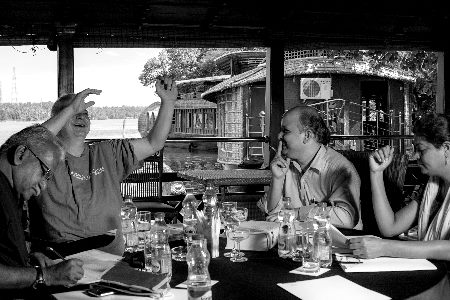From Chennai to Trivandrum – A confluence of cultures at the Ashtamudi Lake

 Photo: Goethe-Institut / Roy Sinai
Photo: Goethe-Institut / Roy SinaiA report on the ambitious Poets Translating Poets encounter that featured four languages, nine poets, three translators and a last minute location change from a rain-lashed Chennai to a gentle-breezy Trivandrum.
When the nine poets and three translators descended at The Leela Raviz Kovalam in Trivandrum, some minus their bags, I sensed an early anti-climactic sigh. They had overcome various odds to get to this point, with miles of road, rail and air travel behind them, and a quick agreement to a last minute change of plans on the workshop location. As news started trickling in of the rising floodwaters in Chennai, Dr Martin Wälde, Director, Goethe-Institut Mumbai and Project Director, Poets Translating Poets, made frantic calls to the host Goethe-Institut in Chennai to work out a Plan B. “Chennai was reeling under massive floods that led to the airport closure and days of power cuts – a decision had to be taken to shift the workshop to another location, or cancel it altogether.”It is perhaps a testimony to the teamwork of the Goethe-Institut employees in India that, in spite of the project leads being split across Mumbai, Germany, Chennai and Trivandrum, an alternative plan was chalked out and transitioned to in a smooth fashion. With Dr Helmut Schippert (Director, Goethe-Institut Chennai) in Germany and Dr Wälde, along with Programme Coordinator Jayashree Joshi in Mumbai and Library Head Geetha Lakshman in Chennai, an SOS call was made to move the workshop to Goethe-Zentrum in Trivandrum. Syed Ibrahim, Director Goethe-Zentrum Trivandrum, took a few hours to work out an alternative location, made travel arrangements and brought us to the Leela Raviz at Kovalam, a two-hour drive from the Trivandrum airport. As the poets started arriving at the hotel on Dec 7-8, the relief was palpable.
 Photo: Goethe-Institut / Roy Sinai
Photo: Goethe-Institut / Roy SinaiThe relief, in no small measure, was also because of the wonderful setting. Perched on a small hill, one had an unfettered view of the picturesque Kerala backwaters and small houseboats buoying by the bank. This was to be home for the poets, who for the next three days were to sit in closed groups discussing poetry under coconut palms, armed with swaying syllables.
Bringing forth different worlds
The poets and translators brought not just four languages, but also multiple universes to the table. The Hungarian poet and translator Orsolya Kalász, from Berlin who writes in both Hungarian and German, brought her intimate experience and knowledge of living and writing in two linguistic worlds. Nicolai Kobus, poet, translator and occasional copywriter from Hamburg, brought his sense of musicality and knowledge of German poetic traditions to fore. The German postmodern poetry traditions with all its experiments, linguistic idiosyncrasies and cerebral themes, could be found in poems by Ulf Stolterfoht of Berlin who, incidentally, also operates Brueterich Press, a small publishing house dedicated exclusively to poetry.On the Indian side, six poets represented the languages Tamil, Malayalam and Kannada. Sukumaran, one of the stalwarts of modern Tamil poetry, has published six volumes of poems, six volumes of essays and articles, and a novel in Tamil. He also translates from Malyalam to Tamil, and has been known to combine the two great trends of Tamil poetry in the sixties and the seventies – introspection and social awareness – with a reflective grace 1. Sukirtharani, a feminist Dalit poet and teacher writing in Tamil, is edgy and raw – her poems take on the caste system and offer a subaltern narrative of double oppression faced by Dalit women. Her poems offer an astonishing glimpse into the lives of Dalit women, a context not often reflected on the world poetry dais.
Anitha Thampi and Veerankutty represented Malayalam voices. Anitha, a Mumbai- and Thiruvananthapuram-based poet (and lyricist for Malayalam films), came with wide-ranging experience of being translated in over 12 languages. Her poems speak of the female, the body and her subjective consciousness laid against the personal-political. Veerankutty, a Malayalam professor at the Government College in Madappally known for his poetry on the environment and ecology brought up the second half of the Malayalam duo.
Mamta Sagar, a Kannada poet, playwright and academic, lent her performative vibrancy to the project. Her poems resonate with lyrical fervour and she brought with her deep concern for social justice and gender. Bringing up the rear was the Kannada poet, short story writer and columnist Abdul Rasheed. Abdul had translated Hemingway, Rilke, Camus, Rumi, Pushkin and other world writers into Kannada. In this milieu of fresh political and social contexts, images and sounds, the translation encounter began.
Running a tight ship with a sharp schedule meant the literary huddle was focused and destined to be productive in spite of the complexity of its diversity. The interlinear translations of the poets’ work were circulated beforehand, but it was here that the poems assumed a body and life in repeated recitations by the original writers, intense negotiations and probing questions. If Ulf wanted to know about the Dalit context of Sukirtharani’s work, in an intense translation session that went way past the late evening hours, Orsolya underwent an emotional churn as the meaning of Sukirtharani’s words hit her.
At the top of the pole
planted in my vagina,
the flag of our freedom shall fly,
painted in the colour of blood.
(From: The Flag of Freedom von Sukirtharani)
Closer to home, new bonds were formed. On a riverboat ride across the backwaters one evening, as Mamta, Sukirtharani and Anitha sat close and spoke about everything from poetry, female bodies to men, one could see a tapestry of new relationships and understanding being formed.
Of the absence and presence of languages
There were worlds within worlds that surfaced often dwarfing the meta-narratives of culture and identity. Their place was taken by subjective positions and languages within languages. For Orsolya, her own preoccupation of straddling between Hungarian and German came forth in both her poems and conversations.Who will come into my language?
I ask you
you ask me
you restless one.
Come on,
ask me anyhow, you me anyhow, then I you again.
Is there a gate in your language, girl,
that opens to my heartrace?
Hear me anyhow, you me anyhow, then I you again.
What can the tears in your language do?
(Die Sprache gibt den Löffel ab by Orsolya Kalász)
 Photo: Goethe-Institut / Roy Sinai
Photo: Goethe-Institut / Roy SinaiIt is a battle that finds vast resonance in a multi-lingual India. Here, where even a child speaks more than two languages, Orsolya’s predicament was deeply felt. As Sukumaran, later explained, “Orsolya’s poems were more relatable – common themes and emotional tonality, with a much warmer palette. In comparison, German poetry that I encountered here was more idea-based, more cerebral.” This, however, didn’t stop him from opening up to influences that transmutation affords. Sukumaran sensed a new energy of experimentation stemming from these poems, as compared to the older German poets he had read. “We have rarely read contemporary German poets, so it was a pleasure to engage so closely with their work. For instance, Nicolai’s use of structure was revealing in the way he tried to express his ideas. He expressed his magic within two spheres: personal melancholy of a man, and his extant space in the lonely universe. His lone voice reflects through the universe and for the universe.” This also provided an impetus for him to experiment: “I will go back and try to reorganise my patterns, use different structures. This has been an interesting experiment.”
The process also led to cultural serendipities. In the same poem, Orsolya used the word ‘handkehle’ as a metaphor to mean the ‘neck’ of the hand i.e. the base beneath the palm from where the fingers emerge.
Dir zeigt sie nur ihre Kehle
die Handkehle.
There is a word to describe this ‘hand neck’ in Hungarian, but not in German. It was apt that for a poem about multilingualism, in which she created a word in German to mean what she wanted to say, the Malayalam poets found a similar word in Malayalam. In spite of its absence, the Hungarian language found its presence in the encounter, bringing more unimagined contexts into the equation. As Annakutty Findeis, the Malayalam interlinear translator said, “There are so many silent space realms in every language, which can be hinted at.”
For the interlinear translators the choice of poets is what allowed them to glimpse into contemporary German culture. As Kannada translator MP Rajendra explained, “We last read Gunter Grass, who addressed issues that everyone knew. These poets brought something ‘new’, it allowed me to challenge what I knew about German culture, art and music.” This process of discovery was fraught with restraint, as the subjective was muzzled and the objective privileged. “I had to be absolutely blank, avoid making any judgements while making these translations,” voiced Tamil translator P. Seralathan, who used Walter Benjamin’s essay, The Task of Translator, as an inspiration while making his translations.
These were bare-boned, linguistic explorations. Along with these, another more aural sphere of experimentation occurred.
The rhythm in poetry
 Photo: Goethe-Institut / Roy Sinai
Photo: Goethe-Institut / Roy SinaiNegotiations abound, aural satisfaction was sought. As Nicolai said of Mamta’s translation of his poem Das Wespennest, “It sounds like the phrasing and attitude fits.” This attempt to align and to be aligned to the rhythm of the original poem, perhaps as testimony to Nicloai’s keen interest in the musicality of poetry, was an oft repeated feature of the workshop. In translating Anita Thampi’s Writing – a short, snaky poem with a Haiku-like construction – Kobus manipulated the German language to work with the original poem in Malayalam. He explained the challenge: “In German, to describe these same images, you need to use very long words. So here, to use short words was very difficult.”
The dissonance between rhythmic structures was also felt in the Tamil-German workshops. As Tamil is an agglutinative language (like Hungarian), said Seralathan, it lacks prepositions and allows for vast contractions. This is unlike German, which is an inflecting language, where each word can be quite long. This led to challenges in creating similar rhythmic structures in translations.
On the other end of the spectrum was Mamta Sagar, who sensed performance in the work of the others. Mamta, herself a performance poet, brought the four women poets of the workshop together for a performance-reading of Orsolya’s poem Die Sprache…, in all the four languages, at the public presentation held on the final day of the encounter at Goethe-Zentrum Trivandrum. For the largely Malayalam audiences that possibly held the knowledge of at least two of the languages spoken on that stage, to hear one voice flow through multiple languages was an experience to behold.
And this is perhaps where the expectations from the workshop were not just met, but exceeded. As Dr Schippert felt, “I didn’t expect that the talks and explorations into the other language would go so far deep and with this fierce an intensity.” And that, while the poets held on their own, they also came together in unexpected ways. In spite of different personalities, no one seemed to stand apart from the group,” he observed.
As the poets were headed to their presentation venue, they decided to get a group picture. At once they jumped, as the camera click fell into position to capture them mid air. In that lightness of being, I saw a moment when they let go of their languages and images and opened doors to newer cultures. Algerian-born Italian author Amara Lakhous, Clash of Civilizations Over an Elevator in Piazza Vittorio once spoke of translation as a journey over a sea from one shore to the other: “Sometimes I think of myself as a smuggler: I cross the frontier of language with my booty of words, ideas, images, and metaphors.” The nine poets and three translators of this workshop were smugglers, who whisked their treasure of words from one culture to another. The difference was that with each journey, the treasure grew to glow brighter – and even more spectacular!
References
- From: The Rapids of a Great River: The Penguin Book of Tamil Poetry, 2009. Eds Lakshmi Holmstrom, Subashree Krishnaswamy, K. Srilata.
Rashmi Dhanwani



